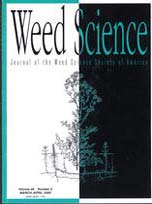A model is presented of the spread of a weed from a point source, with dispersal being both unaided and aided by a combine harvester. Four “type” weeds were modeled, chosen to represent species of differing population and dispersal ecologies and based broadly on Avena spp. (wild oats), Raphanus raphanistrum (wild radish), Bromus spp. (bromegrass), and Fumaria spp. (fumitory). Wind-adapted species were excluded. The greatest rate of spread was predicted to be for R. raphanistrum and the least for Fumaria, regardless of whether dispersal by combine harvester was included. Rate of spread was more sensitive to dispersal parameters than to demographic parameters and increased up to 16-fold as soon as any seeds were dispersed by the harvester. Given that uptake by the harvester is a function of phenology of seed production and dispersal, better data on such processes is required for weeds. Because rate of spread is more dependent on dispersal than on demographic factors, greater attention needs to be given to describing dispersal frequency distributions and especially to analysis of their shapes.
Nomenclature: Bromus spp., bromegrass; Raphanus raphanistrum L. RAPRA, wild radish; Avena spp., wild oats; Fumaria spp., fumitory.





